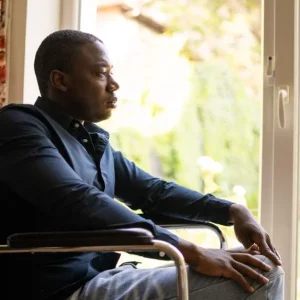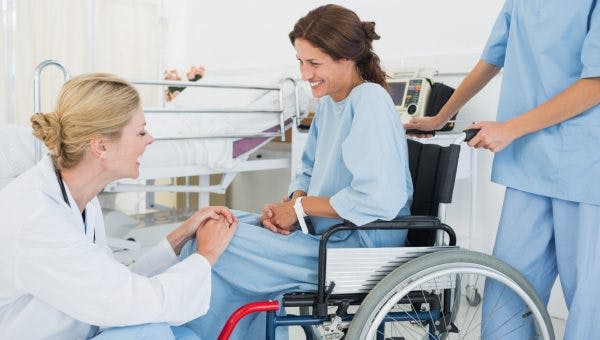Although muscle spasms after spinal cord injury may be uncomfortable or painful, they can often be a sign of recovery, especially in individuals who initially experienced paralysis after their injury. When muscle spasms are not managed properly, they can cause further complications. Fortunately, there are many ways to effectively manage muscle spasms after spinal cord injury.
This article will discuss the causes of muscle spasms after a spinal cord injury, the importance of a proper rehabilitation regimen, and how to promote recovery.
What Causes Spasms After Spinal Cord Injury?
The spinal cord serves as the communication pathway between the brain and rest of the body. When the body receives sensory input, such as the sensation of heat on the skin, it sends that information through the peripheral nerves to the brain via the spinal cord. Once the brain receives these sensory signals, it processes the information, and then sends the appropriate signals back down the spinal cord to tell the muscles how to react.
For example, when your hand gets close to a hot stove, your peripheral nerves will send a signal through spinal cord to the brain saying it is getting hot. Subsequently, your brain will send a signal back down through the spinal cord to tell the muscles in your arm to move your hand away.
However, when the spinal cord sustains damage, sensory information is unable to reach the brain. Because of this, the stimulus travels back down to the muscles, causing them to hyper-react, which can result in muscle spasms.
To further illustrate this, reconsider the example above. In this example, the hand was getting gradually warmer, and information regarding the hot stove reached the brain, was processed, and was thoughtfully responded to.
However, this reaction changes when you touch something that burns you. Instead of the sensory information travelling through the spinal cord to the brain for consideration and then back to the muscles, the nervous system realizes there needs to be a faster reaction.
Therefore, when the signal that your hand is being burned reaches the spinal cord, the spinal cord initiates a muscle reflex, sending a signal directly back to the muscle to jerk away. A similar process may occur to individuals following spinal cord injury.
If sensory information is unable to reach the brain due to a lack of neural connections in the spinal cord, signals can be sent back to the muscles, resulting muscle spasms.
Muscle spasms may also occur if the body enters a state of spinal shock after injury due to swelling within the spinal cord. Spinal shock refers to the temporary loss of functions and reflexes below your level of injury (the lowest region of the spine where movement and sensation are intact).
This inhibits the muscles’ ability to contract and causes them to become loose and floppy. When swelling is reduced and proper blood flow is restored, movement and sensation may gradually return, causing hyper-responsive reflexes that result in jerky muscle spasms.
Involuntary muscle contractions, or spasticity, can also appear in the form of jerky muscle spasms and prolonged stiffness in the muscles. Some movement is better than no movement, and although muscle spasms can be uncomfortable and even painful, they can indicate a positive sign of spinal cord injury recovery.
Why Muscle Spasms in Paralyzed Legs Can Be a Sign of Recovery
Individuals may experience paralysis after a spinal cord injury. The chances of this occurring depend on the severity (or completeness) of the injury. In a complete spinal cord injury, the spinal cord is fully severed, meaning there are no existing neural pathways below the level of injury. However, incomplete spinal cord injuries have spared neural pathways because the spinal cord is only partially severed.
Although paralysis usually means there are no existing motor or sensory signals below the level of injury, muscle spasms in paralyzed legs or other parts of the body after an incomplete spinal cord injury can indicate that there are some neural connections remaining.
This is great news for recovery because the pathways can be rewired with the help of neuroplasticity, the nervous system’s ability to heal and rewire itself. Neuroplasticity strengthens existing neural pathways and creates new ones to help restore communication between the brain and muscles.
It is best activated through high repetition of therapeutic exercise, or massed practice. The more a muscle is exercised, the more the nervous system will strengthen its neural connections and restore function. Thus, there is hope for individuals with muscle spasms in paralyzed legs and an incomplete spinal cord injury to potentially regain movement, especially through passive exercise.
How Muscle Spasms After Spinal Cord Injury Can Be Helpful
The presence of muscle spasms can signify functional improvements which can prevent the development of other complications of a spinal cord injury, including autonomic dysreflexia and pressure sores. Autonomic dysreflexia is characterized by sudden changes of autonomic function such as blood pressure and heart rate, and is triggered by irritating (noxious) stimulation below one’s level of injury.
Pressure sores are also likely to occur due to immobility and loss of sensation, which make it difficult for survivors to know when the skin is becoming irritated. Fortunately, when muscle spasms appear below the level of injury, it means that some communication exists and there is potential to receive sensory stimuli.
In this light, muscle spasms after spinal cord injury can be viewed as a sign of recovery and a stepping stone towards regaining movement and sensation, which can help avoid further complications.
Additionally, muscle spasms increase muscle tone in the legs which can help individuals prop themselves up to stand, transfer in and out of a wheelchair, and even walk. Muscle spasms can also help prevent muscle atrophy (shrinking of the muscles) and promote blood circulation throughout the body.
Top Spinal Cord Injury Muscle Spasm Treatments
While there are various ways to manage muscle spasms after spinal cord injury, it’s important to also use them as a stepping stone towards recovery. Muscle spasms indicate that there are existing neural connections, but the nervous system needs your help to strengthen those connections and restore function.
Spinal cord injury muscle spasm treatments can include:
1. Prescribed Medication
Muscle spasms after spinal cord injury can be painful depending on the severity. Muscle relaxants are often prescribed to help reduce pain and symptoms of spasticity. This type of medication typically works by altering the chemical balance in the central nervous system and temporarily inhibiting muscle spasms. Muscle relaxants can be locally injected or taken orally for a more general effect. Effects often wear off within a few hours.
While medication is helpful, it does not treat the root cause of muscle spasms after spinal cord injury, which is the disruption in signals between the spinal cord, brain, and muscles. Fortunately, communication can be restored through rehab exercises.
2. Rehab Exercises
Therapeutic exercises help stimulate the nervous system and activate neuroplasticity (rewiring of the central nervous system). Exercising consistently also helps reduce the excitability of hyperactive muscles. The more you practice a skill, the more the nervous system will strengthen its neural connections.
Rehab exercises can be done actively on your own, or passively with the assistance of your unaffected limbs or therapist. Your therapist may also recommend stretching exercises to help manage muscle spasms. Lengthening spastic muscles can help reduce spasms and expand range of motion. Your therapist can also provide you with a variety of exercises to safely practice at home.
3. Home Therapy Program
Having a proper home exercise program for spinal cord injury is crucial during recovery. The best way to heal the spinal cord and reduce muscle spasms after an injury is to promote neuroplasticity as much as possible. While many survivors attend 1-2 therapy sessions a week, it is often not enough to achieve your goals and see improvements. Therefore, practicing therapeutic exercises at home is essential. To help you stay motivated to achieve high repetition of therapeutic exercises you can use interactive neurorehab devices like FitMi.
FitMi is a gamified neurorehabilitation device designed to improve full-body mobility. It provides you with various therapeutic exercises based on your ability level. FitMi helps you stay motivated to achieve massed practice by keeping track of your progress and unlocking more challenging exercises as you improve. The more you practice in between your therapy sessions, the higher the chances of reducing muscle spasms after spinal cord injury.
4. Orthotic Devices
Sudden, jerky movements caused by muscle spasms can sometimes cause you to hit nearby objects, increasing your risk of injury. To help control the movements, therapists may recommend wearing orthotic devices such as braces or splints. These can help hold your body in place to prevent spastic muscles from contracting further. Orthotics can also help mildly stretch tight muscles for continuous muscle lengthening.
5. Botox Injections
Botulinum toxin, or Botox, is a nerve block that is directly injected into spastic muscles. These injections help provide temporary relief of neuropathic pain and muscle spasms, usually ranging from 3-6 months. However, similar to medication, Botox does not address the underlying cause of muscle spasms after spinal cord injury.
Therefore, it’s important for individuals to take advantage of reduced spasticity during this period and focus on achieving high repetition of therapeutic exercises to activate neuroplasticity and promote recovery.
6. Surgery
Another type of spinal cord injury muscle spasm treatment is surgery. However, surgery should only be considered once all other options have been exhausted due to its highly invasive nature. For example, one procedure involves implanting an intrathecal baclofen pump into the spinal column.
Baclofen is a commonly-prescribed medication for spasticity. With an implanted pump, a small dose can be directly administered into the spinal fluid to relieve spasticity. Other procedures like a rhizotomy involves nerve incisions to denervate the spastic muscles.
Treatments for muscle spasms may include a combination of different methods. Be sure to consult with your doctor if you are interested in more invasive procedures. They can provide you with treatments that are safe and suitable for you.
Managing Muscle Spasms After Spinal Cord Injury
Muscle spasms after spinal cord injury occur due to the disrupted communication between the brain, spinal cord, and body. They can be uncomfortable, painful, and interfere with your ability to perform your daily activities.
Fortunately, there are many ways to effectively manage the effects of muscle spasms including medication, orthotic devices, or Botox injections. To treat the root cause of muscle spasms after spinal cord injury, it’s important to establish a proper home exercise regimen. Consistently practicing therapeutic exercises is the best way to stimulate neuroplasticity and promote healing.
We hope this article helped you understand why muscle spasms after a spinal cord injury occur, and how they can be a good sign of recovery.











